Unraveling drone laws for educators

This article is written to help drone training educators and schools who offer drone training courses to understand the legal issues surrounding drones.
Why? We need drones in the schools to promote STEM education. Why am I all pro-STEM education? My wife and I ran a LEGO robotics business for a while where we taught physics and robotics. If you are an educator or school needing material, I have created a dedicated drone education resource page where I will continually add resources to help you in this area. :)
If you are setting up a drone program, you should check out my article 5 Problem Areas When Integrating Drones Into Large Companies as it brings up many questions that need to be answered by schools or universities setting up a drone program.
Don’t want to read? Watch or listen to the article here while you are doing something.
I. Foundations of Drone Law for Drone Training Educators
From my book Drones: Their Many Civilian Uses and the U.S. Laws Surrounding Them:
The Commerce Clause of the U.S. Constitution gives Congress authority to “regulate commerce with foreign nations, and among the several states.”[1] Congress created the Federal Aviation Agency by the Federal Aviation Act of 1958,[2] but in 1967, Congress changed the name into the Federal Aviation Administration (“FAA”) and moved that agency into the Department of Transportation (“DOT”) which is a Presidential cabinet department.[3] The FAA has been given by Congress jurisdiction to regulate navigable airspace of aircraft by regulation or order.[4] . . . .
The FAA has created regulations,[5] known as the Federal Aviation Regulations (“FARs”), which govern the certification of only civil aircraft,[6] civil pilot licensing,[7] airspace,[8]

The FAA also “regulates” in multiple ways by creating advisory circulars, or memos or interpretations on the regulations. Regulations ARE the law while advisory circulars, memos, and interpretations are the FAA’s opinion of how to follow the law, but they are NOT the law. However, they somewhat become law in effect because even though they are not law, the interpretations change people’s behavior who would rather not pay an attorney to defend them in a prosecution case. They in effect stay out of the grey area like the guy with the yellow shirt in the graphic. When I say grey, I don’t mean that it is not clear as to whether it is law, the grey area is not law, but I mean that it is unclear as to whether a judge would agree with the FAA’s opinion and would find the guy in the yellow shirt to be in violation of the regulations. In short, the law is what you get charged with violating, but the interpretations/memos/advisory circulars are what determine if you are on the FAA “hit list” so they can go fishing to try and get you with the law.
Keep in mind that the FAA has the super vague regulation which prohibits you from acting in a careless or reckless manner[14] which functionally acts as a catch-all. This gets thrown in as a charge for almost every FAA prosecution out there. Out of the 23 FAA enforcement actions against drone operators I studied, all 23 of them were charged with violating 91.13 (107.23 was NOT around at the time the prosecutions started).
Why are these regulations created? They are really safety standards that have been proscribed by the FAA for us to follow to maintain the safety of the national airspace system. The FARs apply to almost everything that touches aviation. A good exercise is to find something that the FARs do NOT regulate. Below is a graph to help you understand the different areas that the FAA regulates which all contribute to the safety of the national airspace system.
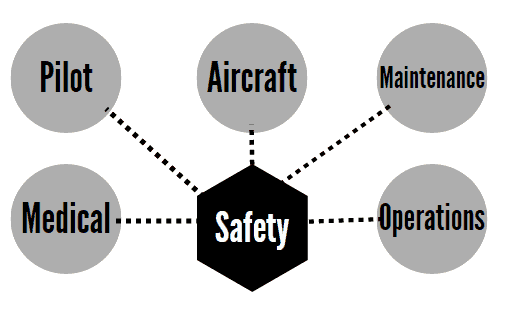
II. How Drone Training Educators Can Fly Legally
Unmanned aircraft can be flown as public aircraft under a public COA, as civil aircraft flown under a Section 333 exemption, as non-recreational unmanned aircraft under Part 107, or under Part 101 as a recreational unmanned aircraft. The classification of the aircraft will determine which set of regulations and standards are used. Below is a graphical summary of the requirements of each of the different classifications. Purple is where the burden of determining the standards is placed upon the remote pilot in command. Grey is where the FAA determines the standards.
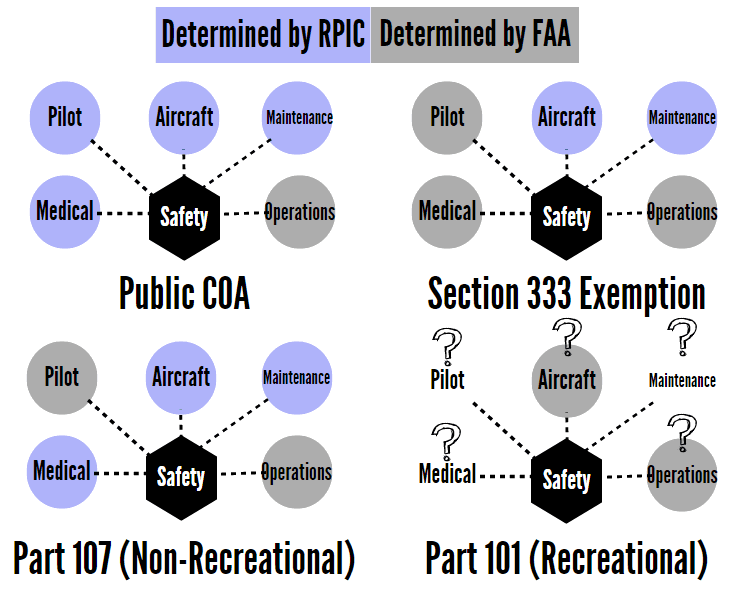
We are now going to explore each of the 4 options as they relate to drone education.
A. Public Aircraft Operations Under a Public Certificate of Authorization (COA).
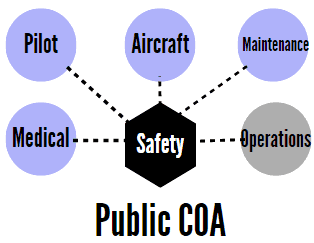
Public aircraft are those that (1) fall into 1 of 5 statutorily defined owned/operated situations,[15] (2) are flying for a governmental purpose,[16] and (3) are NOT flying for a commercial purpose.[17] The big benefit to obtaining public aircraft status is the public aircraft operator determines their own standards for the pilot, aircraft, maintenance of the aircraft, and the medical standards of the pilot, but they still must fly under the restrictions given to them by the FAA as listed in the public certificate of authorization (COA).
Unfortunately, educators and schools are unable to fly unmanned aircraft under a public COA for education. (Keep in mind many universities are flying under public COAs but for purposes like aeronautical research.)
The FAA answered the question of whether education was a governmental function in a letter from Mark Bury of the FAA’s Chief Counsel’s Office to Jim Williams of the UAS Integration Office by saying:
If the FAA now were to read a concept as broad as education into the statute, it could exponentially expand the operation of unregulated aircraft. As a concept, education is not restricted to age or curriculum, and would include aviation education such as flight schools. All manned flight schools are civil operations, and are subject to significant regulation – none use public aircraft to teach students to fly, nor would we allow uncertificated pilots operating unregulated aircraft to teach others. The same must hold true for UAS, as the statute contains no distinction in the type of aircraft used to conduct a public aircraft operation. Accordingly, we must answer in the negative your question of whether a university could, in essence, conduct a UAS flight school using its COA.
You also asked whether some limited form of education could be found governmental. It would not be defensible to include education as a governmental function but then draw artificial limits on its scope, such as the level of education being provided, the curriculum, or the aircraft that can be used. Since our agency mission is the safe operation of the national airspace, including the safe integration of UAS into it, any analysis of whether the list of governmental functions can reasonably be expanded to include education must contain a clear consideration of the overall effect that such a change would have on aviation as a whole. There is nothing in the law or its minimal legislative history to suggest that Congress intended education to be a governmental function that a state needs to carry on its business free of aviation safety regulations.
Let’s go to the next option for educators.
2. The Section 333 Exemption for Drone Training and Education
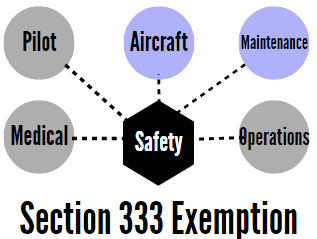
Section 333 of the FAA Modernization and Reform Act of 2012 says:
(b) ASSESSMENT OF UNMANNED AIRCRAFT SYSTEMS.—In making the determination under subsection (a), the Secretary shall determine, at a minimum—
(1) which types of unmanned aircraft systems, if any, as a result of their size, weight, speed, operational capability, proximity to airports and populated areas, and operation within visual line of sight do not create a hazard to users of the national airspace system or the public or pose a threat to national security; and
(2) whether a certificate of waiver, certificate of authorization, or airworthiness certification under section 44704 of title 49, United States Code, is required for the operation of unmanned aircraft systems identified under paragraph (1).
This authority given to the FAA was created before Part 107 or Part 101 were created. The FAA’s view at that time was that all the FARs applied to civil aircraft. These regulations were very burdensome to comply with. For example, 14 CFR 91.119 requires the aircraft to be at least 500ft away from non-participating people and property which makes it very hard to do aerial photography from 500ft! The FAA was given authority under Section 333 but needed another legal tool to help the drone operators get airborne.
The FAA used the authority given to them in Section 333 to determine that the unmanned aircraft did not need an airworthiness certificate. The remaining regulations were taken care of by using the Part 11 exemption process. This is why the paperwork allowing you to fly was nicknamed the 333 exemption, even though Section 333 does NOT provide any exemption powers!
The operator operates under all the federal aviation regulations, except for those specifically exempted. Where exempted, the operator flies according to the restrictions which will provide an equivalent level of safety as the regulations they were exempted from.
The FAA wisely decided to create restrictions in the 333 exemption which required the pilot in command to determine the airworthiness of the aircraft and determine proper maintenance; however, all the pilots were still required to have a sport pilot license or higher, a driver’s license or a 3rd class medical, and they were still limited by Part 91 and its restrictions regarding their operation.
Exemptions are operation specific. The first group of exemptions were for the cinematography industry which was focused on creating movies, not on instructing or education. The restrictions slowly morphed over time to be “eh O.K.” enough to allow for other industries to use the 333 exemptions.
Over a year after the first exemptions were granted, on November 20, 2015, the FAA finally granted a Section 333 exemption to Kansas States University to allow for flight instructing.
The FAA issued their educational memo on May 4, 2016 and Part 107 was released June 21, 2016 which is far easier to operate under than the Section 333 exemption. The idea behind the memo was to allow people to fly for purposes of education without having to obtain a Section 333 exemption.
To further promote flight training, the FAA granted on November 14, 2016 an amendment to a giant list of exemptions to allow many exemptions to conduct training of students. See FAA Updated Section 333 Exemptions.
3. The FAA’s Memo on the Educational Use of Drones and Part 101 (Recreational Operations)
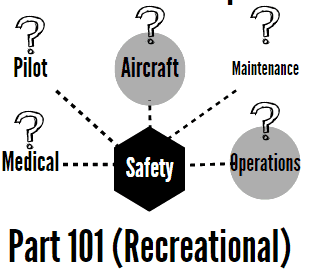
a. Background to Part 101 Subpart E.
Up until Part 101 Subpart E went into effect, the FAA was pretty much echoing the definition of model aircraft as defined in Section 336 of the FAA Modernization and Reform Act of 2012. Part 101 Subpart E is just a copy-paste of Section 336.
Keep in mind that the terms “model aircraft” and “recreational aircraft” are used interchangeably throughout the FAA’s website and material even though recreational aircraft might not be a miniature model versions of a full-sized manned aircraft (e.g. Phantom 4 as opposed to a model P-51 Mustang).
The FAA’s treatment of Section 336 is really weird because the FAA uses Section 336 to somehow define model aircraft but Section 336 was specifically directed at the FAA telling them what NOT to regulate. The FAA ignored what Congress said in Section 336 twice. Once when the FAA created the new Part 48 registration regulations and secondly when they created Part 101 Subpart E. For a much more in-depth discussion of how the FAA has violated Section 336 see my article on why the registration requirements and regulations are illegal.
The reasons I have question marks over these areas is that the newly created Part 48 regulations and the FAA’s interpretation that all aircraft are required to be registered are being challenged in the D.C. Circuit Court of Appeals. How the court rules will determine the effect of the FAA’s interpretations, Part 101, and Part 107 on model aircraft operations.
b. The Educational Memo
The reason why the educational memo was created was that many universities were wanting to offer classes where students would be required to fly the aircraft. This brought up questions such as “does the university need a Section 333 Exemption?” or “does the student need a pilot license?” There were also spin-off questions such as “can we teach the local 4-H, Boy Scouts, etc. about drones?”
The FAA summed the memo up in three points:
- A person may operate an unmanned aircraft for hobby or recreation in accordance with Section 336 of the FAA Modernization and Reform Act of 2012 (FMRA) at educational institutions and community-sponsored events[1]provided that the person is (1) not compensated or (2) any compensation received is neither directly or incidentally related to that person’s operation of the aircraft at such events;
- A student may conduct model aircraft operations in accordance with Section 336 of the FMRA in furtherance of his or her aviation-related education at an accredited educational institution;
- Faculty teaching aviation-related courses at accredited education institutions may assist students who are operating a model aircraft under Section 336 and in common with a course that requires such operations, provided that the student maintains operational control of the model aircraft such that the faculty member’s manipulation of the model aircraft’s controls is incidental and secondary to the students (e.g. the faculty member steps in to regain control in the event the student begins to lose control, to terminate flight, etc.)
UAS Demonstrations
Hobbyists or enthusiasts can fly at an “accredited educational institution or other community-sponsored events to promote the safe use of UAS and encourage students’ interest in aviation as a hobby or for recreational purposes provided the hobbyist receives no compensation of any kind (honorarium or reimbursement of costs), or any such compensation neither directly or indirectly furthers the hobbyists’ business or operation of the UAS.”[4]
Keep in mind that the last portion is very broad. If you think this might apply to you, the work around is to just do demos inside a completely enclosed building and avoid all these legal gymnastic problems.
Student Use
We were all wondering if the skills learned from education somehow prevented the flight from being recreational. The FAA’s interpretation of recreational was that the operator was not receiving any direct or indirect benefit. Skills would be an indirect benefit so this kept many on the sideslines.
The FAA went on to say that just because a student learns about the knowledge of flight does not make the flight not hobby and recreational when they will use that knowledge to get a degree.[5] The link between knowledge, to degree, to job is just “too attenuated” to be considered outside of hobby or recreational use.
The FAA concluded that UAS flying for “students at accredited educational institutions as a component of science, technology, and aviation-related educational curricula or other coursework such as television or film production or the arts more closely reflects and embodies the purposed of ‘hobby and recreation[.]’”[6]
If the student receives any reimbursement for costs or an honorarium then that is NOT hobby and recreational; however, a student may receive financial aid, participating in a work-study program, or being a paid research assistant to a faculty member teaching the course.[7]
Faculty Use
“Faculty teaching a course or curricula that uses unmanned aircraft as a component of that course may provide limited assistance to students operating the unmanned aircraft” without changing the student’s hobby and recreational classification or the need for the faculty to obtain FAA authorization.[8]
This limited assistance exception is only where the UAS operation is secondary in the course; however, if UAS operations is the primary reason for the course, the faculty member would need authorization, but the student, as defined above, would not.
It is NOT considered hobby and recreational for a faculty member or assistant to operate a drone as part of their professional duties. Additionally, a professor cannot do a “work around” and get the students to fly the drone for purposes of the faculty member’s professional research objectives.
When Does a University’s Class/Operations NOT Fall Into This Exception?
- Faculty operating the drone for research and development
- Faculty supervising students doing research and development using a drone
- UAS flight instruction where the faculty instructor is actively involved in the operation (not incidental and secondary); however, just teaching without touching the controls would be fine. (Think of it like the faculty is the air traffic controller teaching the student how to land the aircraft.)
Problems I See:
- How much of this has been superseded or will be overruled?
- Does the newly created Part 101 nullify the older 336 interpretations? Will the FAA treat the 336 interpretations like they were really Part 101 interpretations?
- How will the Taylor cases in the D.C. Circuit Court of Appeals cause problems to the reach of the interpretations on the 336 protected model aircraft class?
- Keep in mind the FAA mentioned in the Part 107 preamble that they are revising the 2014 model aircraft interpretation.
- Must the Model Aircraft Be Registered?
- Nothing is said in the memo about whether the aircraft must be registered or not. This is most likely an oversight on the FAA’s part since they have been campaigning hard about the need for all aircraft 250 grams or above to be registered.
- The FAA’s interpretation of Section 336 is that it prohibits the specific regulation of model aircraft, not the regulation of all aircraft as a whole like it is some sort of civil rights for drones equal protection clause which does not in any way work with the meaning of “special” in the title to Section 336. In other words, how are model aircraft special (as indicated in the title of 336) if model aircraft are required to be treated like everyone else?
- Are Model Aircraft Special or Not?
- There is something seriously incongruous with the FAA’s view of Section 336 and Part 101 and how Section 336 actually reads. The FAA seems to view 336, and now Part 101, as a means of allowing model aircraft flights without “authorization”[9]when in reality it is specifically addressed at the FAA telling them to not create any rule or regulation governing model aircraft.
- FPV Flying
- The FAA in their 2014 interpretation on the model aircraft rules indicated that FPV racing would NOT fall within Section 336’s definition of model aircraft.[11]An interesting point here is the Federal Aviation Regulations required the pilot to “see and avoid” other aircraft[12] and Section 336 defines the model aircraft as being “flown within visual light of sight of the person flying the aircraft.”[13] This all logically follows that the FAA’s interpretation would be that FPV racing, while possibly permitted under this interpretation, would NOT be permitted under their model aircraft interpretation from 2014 since it would not be considered a “model aircraft” for purposes of Section 336 or Part 101.
So what does all this mean?
There are more problems here than a MacGyver episode.
There are two easy solutions for educators and schools: (1) have the students and teachers all fly indoors or (2) have the teacher/professor obtain a Part 107 remote pilot certificate and one student flies under the direct supervision of the teacher/professor. Part 107 is a far less restrictive than the newly amended Section 333 exemptions.
4. Part 107 (Non-Recreational Operations) Drone Training
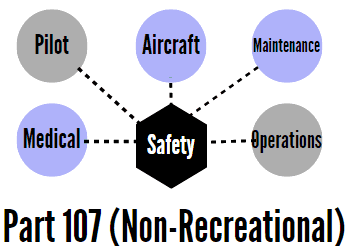
The best choice is for the professor/teacher to obtain a remote pilot certificate. (In-depth step-by-step instructions for obtaining the certificate for first time and current pilots are located here). There are two options for obtaining it:
- Manned aircraft pilots certificated under Part 61 and who are also current with a biannual flight review can take a free online training course. They can then get identified from either a certified flight instructor, an FAA aviation safety inspector, a designated pilot examiner, or from an airmen certification representative. They then file through an online portal. They’ll receive and email later notifying them they can print out their temporary remote pilot certificate.
- Brand new pilots can take the remote pilot initial knowledge exam ($150) at a testing center. Also, manned pilots who are not current will have to take the knowledge exam.
If you are brand new to all of this and don’t know much about Part 107, read What Drone Operators Need to Know About the New Part 107 Drone Regulations.
There are many resources out there to study for the exam. There are some paid courses out there, but I have created a FREE 100+ page study guide for this test.







